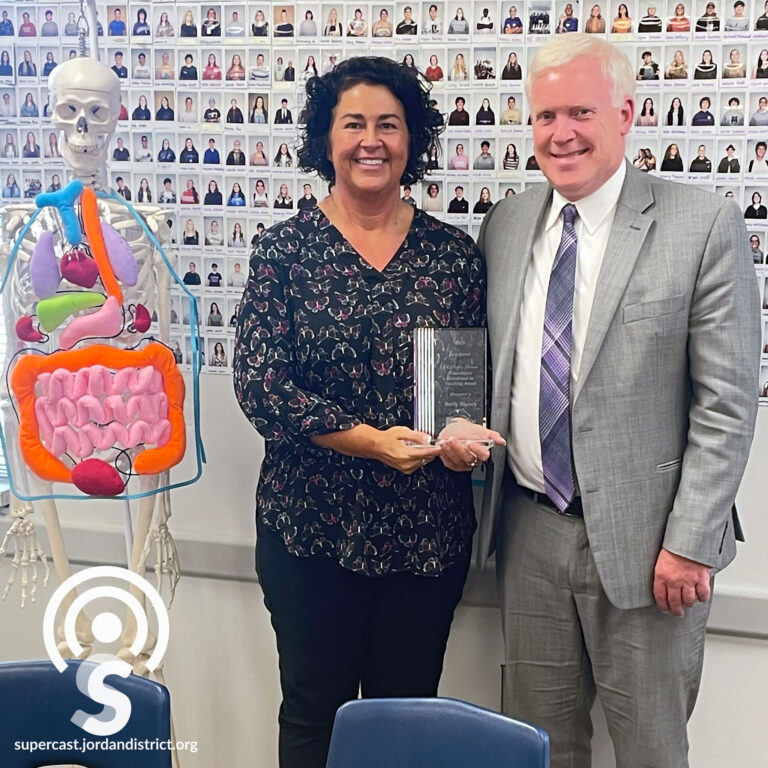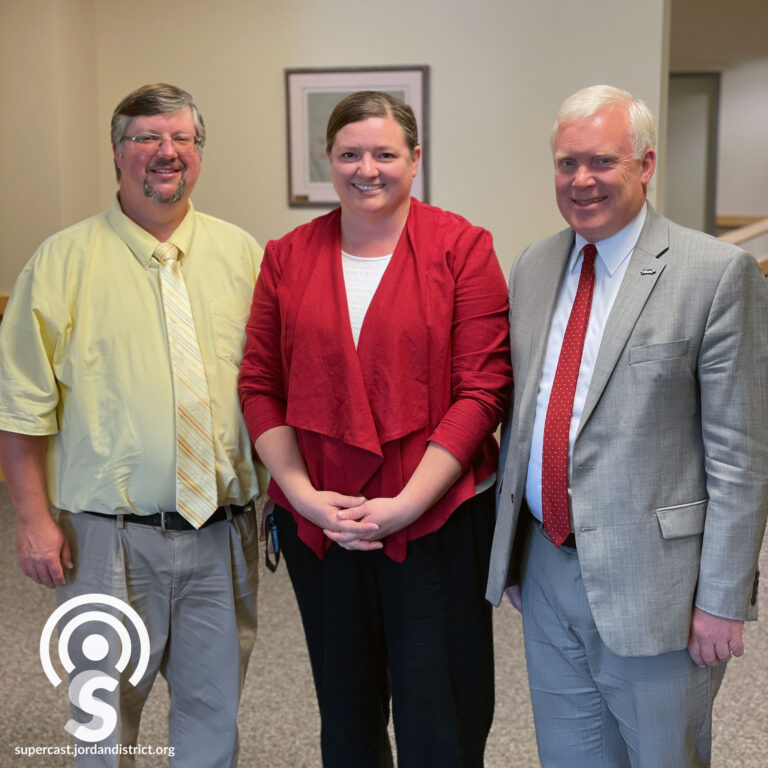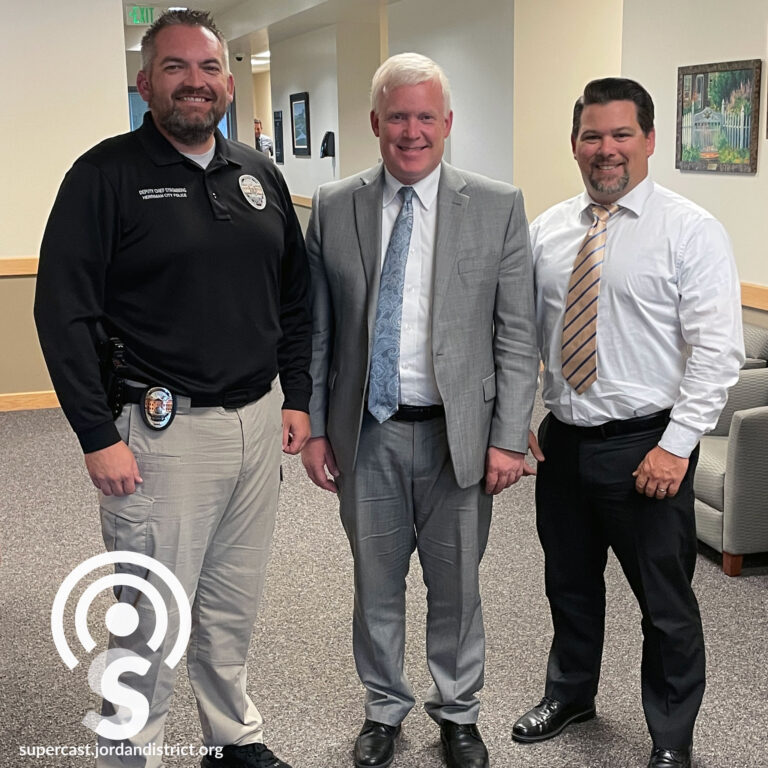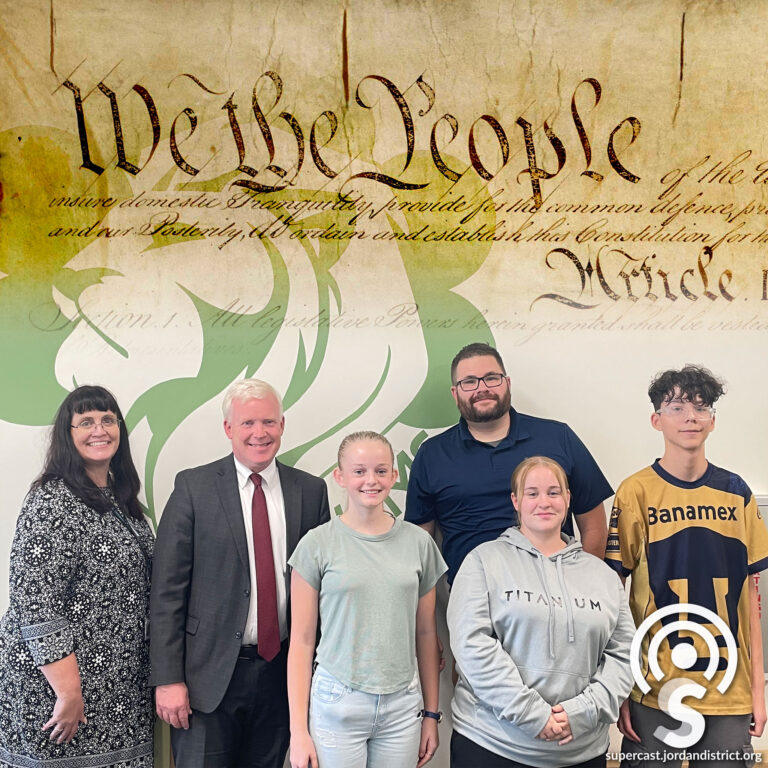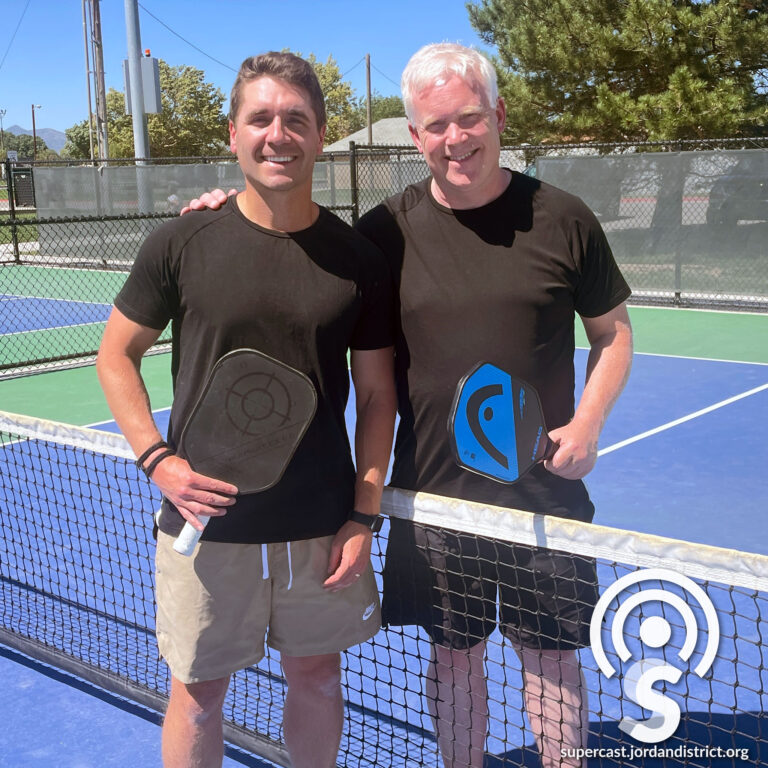She is known as an extraordinary teacher who goes above and beyond for her students every single day. In fact, this amazing educator never forgets a face, keeping a picture and list of every student who has come into her classroom since 2019.
On this episode of the Supercast, meet Riverton High School CTE teacher Buffy Blunck. Ms. Blunck was recently honored as a 2023 “Superstar in Education” by the Utah Education Association. Listen and find out why.
Audio Transcription
[Music]Anthony Godfrey:
Hello and welcome to the Supercast. I'm your host, Superintendent Anthony Godfrey. She is known as an extraordinary teacher who goes above and beyond for her students every single day. In fact, this amazing educator never forgets a face, keeping a picture and list of every student who has come into her classroom since 2019.
On this episode of the Supercast, meet Riverton High School CTE teacher Buffy Blunck. Ms. Blunck was recently honored as a 2023 “Superstar in Education” by the Utah Education Association. Listen and find out why.
[MUSIC]We are here with Buffy Blunck, winner of the Excellence in Teaching Award for 2023 for Jordan School District. Buffy, congratulations.
Buffy Blunck:
Thank you.
Anthony Godfrey:
It's great to be here in your classroom at Riverton High School. Tell me a little bit about the award.
Buffy Blunck:
Well, it was a surprise and I'm very privileged to get it. It was given to me by one of my colleagues and it was one of the ten in the state of Utah that I was able to win. I was one of the ten people and it was a great honor to get this award. They did give me a cash prize for it, which was amazing. So that was nice from Ivory Homes. So that's a neat thing. I was able to do a banquet where I was given the award and I also had the ability to do a speech. I met the other 10 people and was given a poster. It was just a wonderful honor and my principal was there. And then also Melissa Brown and Rochelle Waite, my principal, were there representing UEA and JEA and my involvement with that.
Anthony Godfrey:
Well, congratulations.
Buffy Blunck:
Thank you.
Anthony Godfrey:
It's an honor well deserved. I've long known about Buffy Blunck and the great things that you do in this district, and we've talked about having you on for a long time.
Buffy Blunck:
Yes, we have.
Anthony Godfrey:
Right from the start.
Buffy Blunck:
Being a health teacher, that's why.
Anthony Godfrey:
It's a long time coming, so I'm glad that we're here. I want to talk a little bit about your classroom first of all. The fact that you're a fantastic teacher just is immediately apparent as you walk into your classroom. Tell me about your mug wall. Let's walk over there. Let's walk over and check it out.
Buffy Blunck:
When I came to Jordan School District from Canyon School District and I ended up teaching Health in the classroom, I decided that my theme for the year is, or every year, kind of my philosophy is I'm here for you. And so I really like to get to know all my students, their names, even though I have, right now I have 252 students.
Anthony Godfrey;
Oh wow.
Buffy Blunck:
But I get to know their names and then at the end of the semester, when they leave, they have the opportunity to do a little Polaroid picture. So on my wall, I have all my students starting from 2019 when I kind of came up with this idea. And they're all up on my wall. For the past, I would say, missing COVID, of course, I wasn't able to do that, but you can see even a group of students back there with masks on.
But it just shows my students how much they mean to me. And when they come in and they see their brothers or sisters or their friends, they love to see all of their names and their pictures on the wall. So it's just my little mug wall. And I think they love to see that and see the connection that I have. And I have seniors that come back 'cause I mostly teach sophomores, and they'll come back and wanna get a picture of their senior, or look at them when they were a sophomore. And I don't force them, so it's just something that, if they want to do that, they can, but most of them end up loving to do it. So it's really, and it just makes me happy. It just makes me feel good about seeing all my students and know that they were in my class, and they love to come back and visit and take a picture of themselves or just visit.
Anthony Godfrey:
I love the theme, I am here for you. Then you have a sign laid up at the front of your classroom that says that. So they don't forget it. Every day they know that.
Buffy Blunck:
They know I'm here for them. No matter what, any way, in any capacity, especially teaching health and the way things are going, that is something that I'm always there. I always have lifesavers or treats or if they need anything, it's a safe haven for them to come. We are very open in this classroom and they just know that I love them.
Anthony Godfrey:
Would you say that I am here for you is your philosophy of teaching?
Buffy Blunck:
Yes, it is, it is. That's how I believe the safety and the feeling of my room should be - that I'm always gonna be there for them, no matter what. If they're having a bad day, just having a place to come where they can be themselves or if they are sad, if they need a break, that I'm here for them. So if they come after school or before school, that I'm always there. If they need to reach out through email, that I'm gonna take the time just to show them I care for them.
Anthony Godfrey:
I love that.
Buffy Blunck:
And mostly it's just a smile, knowing their name, saying “hi” to them.
Anthony Godfrey:
Well, the treats and the sign certainly help but it's the way you treat them that makes the difference.
Buffy Blunck:
Yes, I have my tables are in groups. I have fun things all around the room so they're easily entertained so they can keep their focus or lack of focus. Either way, I'm going to care for them.
Anthony Godfrey:
Now even even before coming here I did hear that you had some really exciting visual aids in your class. I do. Tell me about some of the things that you have to help them stay focused.
Buffy Blunck:
I just teach Health and so of course my subject deals with all the anatomy of the body. I also teach Health Sciences for CTE. I'm very heavily involved with ACTE and all the CTE teachers for the state of Utah. So that is a big priority to me is to know the body and to feel safe so I have a lot of stuffed animals of the anatomy parts of the body. I have a lot of visual aids of just the body. I'm in charge of HOSA clubs so a lot of the things are tied into CTSO. I really believe in trying to help kids get into the medical field and obviously learn about that aspect of their lives or that direction they can take at the tech centers. And so that's a big huge priority. I’m also a big advocate for teachers on the CTE level. I’ve gone to Washington a couple times to advocate for teachers at the national level.
Anthony Godfrey:
And you’ve held some leadership positions at the state level?
Buffy Blunck:
Yes, and I still do.
Anthony Godfrey:
Tell me about that.
Buffy Blunck:
I work with ACTE. I've been the president. ACTE is Association of Career and Technical Education and I've been the president of that, and now I'm not the president anymore but I'm on the executive board and plan all the conferences. So we do a mid-winter conference for about a thousand teachers from all over the state. That's in February. I get to plan that and have a lot of fun with that and continue that education for teachers on that and the networking and the camaraderie.
Anthony Godfrey:
That's fantastic. So you do a ton to support students and a lot to support fellow teachers not just in this school but well beyond.
Buffy Blunck:
Yes, but I am blessed. I have an amazing village here at Riverton High School. My teachers here, my colleagues, they know how much I care about them too and how much they've been there for me throughout the years. I do feel their support and their love. I take pictures, we do the faculty slideshow at the end of the year, but it's just something that I love - the camaraderie that I have amongst my teachers. They're my village, they're my people, and so I'm lucky that I have that network. And then I'm able to share that same love and passion to my students. But it starts, you know, with the administration and the teachers and the people that I have surrounding me, including you at the district level.
I am very blessed that way too. To know people that are supporting me. That have moved to the district level that I still know, and to know that I have people backing me. Even at the UEA level and the JEA level. I feel like there’s still - there's hope. There's still people that are supporting us and fighting for us teachers to help us be better educators and better people all around.
Anthony Godfrey:
Absolutely. Absolutely true. Now you sure seem to love what you do.
Buffy Blunck:
I do.
Anthony Godfrey:
Every aspect.
Buffy Blunck:
I've been doing this for 26 years and I would never change any of it. I don't regret any of it. I've worked in so many capacities and have a problem with saying no. I do have my no button over here that I push, but I definitely don't know how to say it.
Anthony Godfrey:
It looks like it's stuck. It doesn't work.
Buffy Blunck:
It is. I just really believe in being involved. I think that's my biggest thing, I like to be at the games. I like to help out. I'm on committees. I think the more involved you are the better, you know what I mean?
Anthony Godfrey:
I love that. Thank you for everything that you're doing.
Stay with us when we come back more with Buffy Blunck.
Break:
Does your student want to become a veterinarian? Commercial pilot? Programmer? Maybe they want to make a difference as a dental assistant, work in digital media, robotics, welding, or web design. These are just some of the programs offered as part of Career and Technical Education, CTE in Jordan School District. CTE provides the technical skills needed to prepare students for future employment and/or a successful transition to post-secondary education. Career and Technical Education provides work-based learning opportunities. We partner with industry experts to offer apprenticeships and internships with students working in the real world at real jobs while going to school. The CTE experience starts in our elementary schools with the Kids' Marketplace and grows through middle and high school. Our two Jordan Academy for Technology and Careers (JATC) campuses offer unique programs to fit your child’s dreams for the future. To explore all CTE has to offer in Jordan School District visit cte.jordandistrict.org today and let's get your child started on the pathway to a profession.
Anthony Godfrey:
Now this mug wall is difficult to describe if you're not here. It's the smaller Polaroid photos, but this wall is plastered with photos of individual students, mostly with their name written underneath. And it's just - it's really fun to see all these smiling faces all together that kind of tracks the history of life with Buffy.
Buffy Blunk:
Yep. There's, I would probably say, I guess there's probably around a thousand pictures above my wall of all of my students, like I said, since 2019, minus the COVID year. And just at the end of the semesters, I take all my students and ask them to take a picture. And like I said, 99% of them do put their name on it and they're up on my wall.
Anthony Godfrey:
And it's the first thing you notice when you walk in.
Buffy Blunk:
I did it as you walk in.
Anthony Godfrey:
It's an eye-catcher just as you go in. It looks like kind of a mosaic from a distance.
Buffy Blunk:
It does. It does.
Anthony Godfrey:
And you come up and hey, it's real human beings that have had a great time in your class, obviously.
Buffy Blunk:
And they're all the same and just the mini photos they do. So it is a little bit of expense too, but it's worth it. They're worth it to me.
Anthony Godfrey:
It's fantastic.
Buffy Blunk:
When students come in that I don't ever expect to come in just to take a picture or a brother or sister says, "Oh my gosh, that's my brother up there. That's my sister up there. And they loved your class.” It just makes a connection and it makes them feel safe in here, that they knew someone here. It could be a neighbor or somebody there that they recognize. And yes, when I come in and this is what I see, it's the reason why I'm a teacher. My students on my wall, my mug wall. And so it does help me sometimes when I'm tired or exhausted or even just trying to teach a subject that's sensitive. This wall is a representation of why I do what I do.
Anthony Godfrey:
This is a big group of very, very lucky kids to have had your class. And you've got a lot of wall space, Buffy.
Buffy Blunk:
I know, okay.
Anthony Godfrey:
Many years ahead. Plenty of wall space.
Buffy Blunk:
Exactly.
Anthony Godfrey:
I mean, we'll knock down a load-bearing wall and get you some extra space if you need it.
Buffy Blunk:
Thank you. A bigger room, I’ll take it.
Anthony Godfrey:
We can start on the ceiling. Let's not let space stop you.
Buffy Blunk:
It won't. It won't stop me. And it won't stop me being there for my students no matter what. I have a fun time teaching. I love teaching health. I think the subject is something that I lucked out, that I get to teach it because it's something that's every one of us. And I love teaching the fun parts of it. I mean, all the students know that they take my class, they're gonna get it. They're gonna get the real stuff, we're gonna have the real talks.
Anthony Godfrey:
Now, you teach Health and Intro to Health Sciences. Just off the top of your head, what are some of the most important things that students learn in your health class?
Buffy Blunk:
Mental health is a big thing that they love to talk about. And my biggest focus when I talk about mental health is that everybody's different and we gotta break down the stigmas that we have out there. That it's okay if you take medicine, it's okay if you need counseling, and that we all need to be there for each other. The most important thing is to be aware and to listen and to ask hard questions with our friends. And I think that's the biggest thing, but I love talking about it. I love opening up the can of worms and making sure that it's a safe environment to talk about things. And I do. I have students that come and talk to me after and plant seeds and when we break down those walls. That's my favorite part is to break down those walls with mental health.
And then of course, sex ed is always a big huge draw to the class. I love that the curriculum changed, so I have the ability to educate my students on what's important, what's going on out there. Not to focus on any of the taboo things that people are so scared to talk about. I talk about the basics. I talk about what makes us unique, but just the basics of our human anatomy, and then everyone else can fill that in, and we all have our prerogative to do that. So those are the big two topics.
I also love smart goals. I've a big focus on smart goals and mini-goals and atomic habits. We focus on as many things as we can because it's something really hard to learn about as goals, it's always this thing. You're gonna be dealing with goals with your whole entire life. So I try to make sure that they see that they do it every single day and they don't even know they're doing it. So I bring that in in our habits and things that hopefully will change their life.
Anthony Godfrey:
It's a 360 approach to health. I love that you're talking about their mental health, but also that they need to ask hard questions of their friends so they're looking out for the people around them. Now tell me about your Intro to Health Sciences classes.
Buffy Blunk:
Oh, I love it. So that class is a little more intense. I call it honors health if you want to call that. We go into more of the different aspects of the body, but more importantly, we learn about all the different careers. It's an Intro to Health Sciences, so it's an intro into the medical field. So anybody that's interested in going into the medical field or any of those pathways at the tech center or the higher-level classes, my medical anatomy and physiology, EMR, medical forensics, any of those, this would be a class to kind of make sure that this is an area that you want to go into and give them the basics. So when they go into those classes, they'll be successful. We really do focus on careers, diseases, and disorders.
But again, back to the careers. I love learning about and teaching these kids what classes, what careers they can go into, the right pathways to get them excited about that. And that's the same with our CTSO HOSA Club, which is future health professionals, which is an international organization. I work with another teacher, and we really inspire these kids to do blood drives and do all of these amazing things. Speakers come in and talk about their different careers. We have activities that we do. We're doing a service project right now for Maui and collecting toothpaste and toothbrushes and anything medical, band-aids, anything to mail that over with Bluffdale City. So it's a great opportunity that we're starting this week and this next month. So that's kind of what our HOSA club does. And more importantly, I just try to get them passionate about the medical field.
Anthony Godfrey:
So if someone is thinking about being part of HOSA, what do they need to do and what does that involve? Do they need to be in one of your health occupations classes to participate in HOSA? How does that work?
Buffy Blunk:
They do not. We actually just had a club rush week and so we just kind of promoted it with all the other different CTSOs and clubs here at Riverton. Then we go into health classes, we make morning announcements, anyone can join. I do have a lot of students that are in other classes or they heard about it from sophomore orientation, we do that right before school, and obviously during the assembly. We just try to get the word out through posters and banners around the school. So anybody can join, I have an application in my room or in the main office and they can sign up. They do pay $20, it is a national fee and a state fee, and we give them a t-shirt. The expectation is try to get involved once a month at an activity or some things that we end up doing.
Anthony Godfrey:
Friendship and service included no extra charge.
Buffy Blunk:
No extra charge. And food.
Anthony Godfrey:
And food.
Buffy Blunk:
'Cause of course you have to have food.
Anthony Godfrey:
That's right.
Buffy Blunk:
So we're having a little luau with our Maui fundraiser.
Anthony Godfrey:
Fantastic.
Buffy Blunk:
It is a great way for kids that have the same interests are in the same club.
Anthony Godfrey:
Tell me about some of the careers that you cover in the class. And maybe if you can think of some students who have ended up in those careers as a result of exploring them here at Riverton High.
Buffy Blunk:
I do. I actually, my HOSA president that took my class and then a whole bunch of other classes here at Riverton. He is actually now a Surgery Tech student at Riverton Hospital.
Anthony Godfrey:
Great.
Buffy Blunk:
So he is being very successful. I have a lot of students that want to go into be a vet or a pediatrician or an OB/GYN or even have some that want to go into psychology or social work or physical therapy or PA. We cover everything, even recreational therapy is something that some students do. If they're interested in athletics we teach them about athletic training and they can take a class and a pathway. Dentistry. I mean you name it we cover it. Anything from the basic doctor all the way to something a little bit on the way of physical therapy aid or recreational therapy as I said. We cover it all and we make sure that they understand where they are. I've had students who wanted to be a vet their whole life. They kind of take the class, they learn about it and some of them realize it's not all about rainbows and puppies that there is some issues with it, or they're not very good at blood, or they don't want to see animals die. Hopefully, I can even teach them that there might be something else they're interested in.
Anthony Godfrey:
Sure.
Buffy Blunk:
Or number two, that maybe they'll go to plan B because that's not something they want to do and so I save them a lot of time and energy going into the wrong pathway. Anthony Godfrey:
Figuring out early on whether plan A or plan B is going to be the best path is really important. Well, you've taken great care of hundreds of kids over the decades and you've connected them with great careers and helped them explore their interests and understand their own health better. I can't thank you enough for the incredible impact you've had on students.
Anthony Godfrey:
Thank you and thanks for even highlighting me. I'm just lucky to be where I'm at and lucky to be a teacher. I love what I do and I appreciate you talking to me and asking me questions.
Anthony Godfrey;
Well, we're very very lucky to have you in Jordan District, and thanks for everything you're doing.
Thanks for joining us on another episode of the Supercast. Remember, education is the most important thing you'll do today. We'll see you out there.
[Music]
